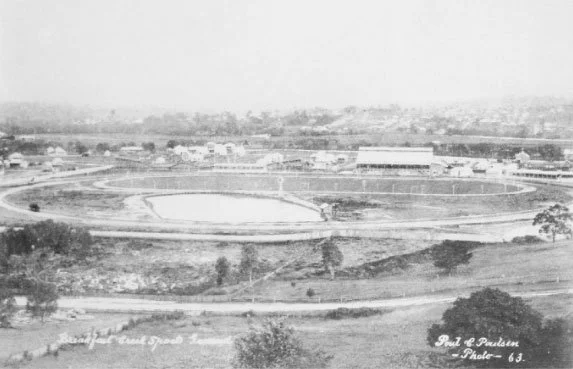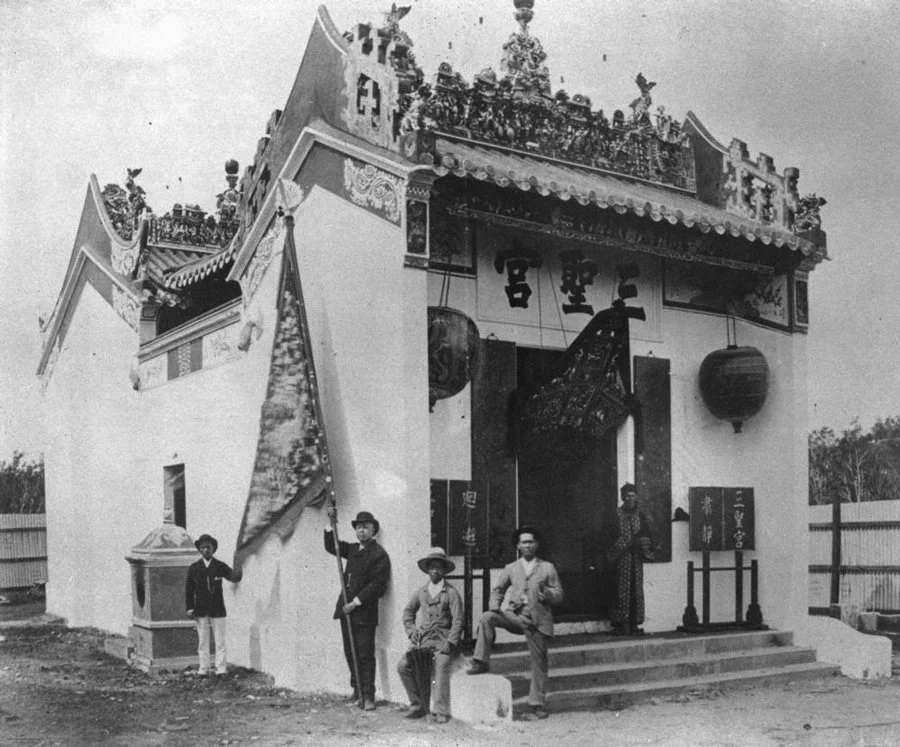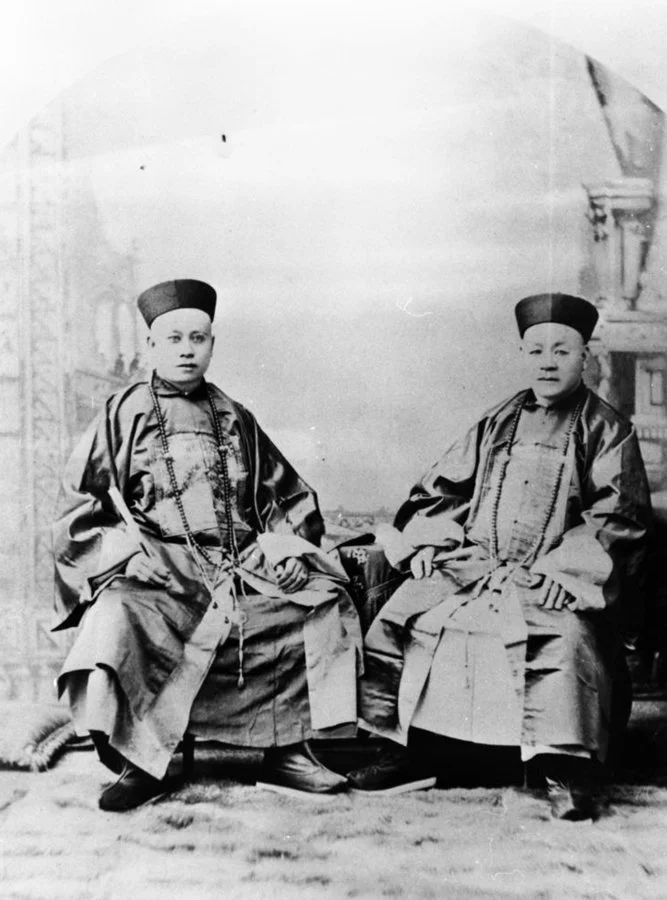Holy Triad Temple 三聖宮
Brisbane was experiencing an unprecedented construction and infrastructure boom during the 1880s, as it evolved from a frontier town into a colonial city. The people were convinced of the unlimited potential of Queensland. This optimism drove prodigal loan spending, inflated land values and an influx of capital from the United Kingdom. This meant that sandstone opulence neighboured homes with flimsy verandas fronted muddy roads. The resident could attend high-class theatre productions, sporting events, and other extravaganzas.
布里斯班在 1880 年代經歷了前所未有的建設和基礎設施繁榮,因為它從一個邊境城鎮演變為一個殖民城市。人們對昆士蘭的無限潛力深信不疑。這種樂觀情緒推動了揮霍的貸款支出、膨脹的土地價值和來自英國的資本湧入。這意味著砂岩富裕毗鄰脆弱的陽台,這些房屋面向泥濘的道路。居民可以參加高級戲劇製作、體育賽事和盛會。
1880-1889
Brisbane's 30 years of rapid economic growth which had commenced in 1861 peaked in the 1880s. At the time, Queensland was believed to be a colony possessing unlimited land, resources, and agricultural, pastoral, maritime and commercial potential.
The total population of Greater Brisbane increased from 37,053 in 1881 to 101,544 by 1891. Of this population, 93.7 per cent were of Anglo-Saxon/Celtic origin. The percentages of Brisbane's population of Chinese origin were 0.37 in 1881, 0.55 in 1886, and 0.45 in 1891.
By 1880, gas street lighting was commonplace in the city, and extending to the suburbs. In 1883, electricity was supplied to the Government Printing Office. Electricity had replaced gas for street lighting throughout greater Brisbane by the early 1890s.
Brisbane's suburban railway system expanded to Sandgate in 1882, Oxley in 1883, and Logan in 1885, with Brisbane's Central Station also completed that year. Brisbane's first tram line opened in 1885 running from Victoria Bridge to the Exhibition and Breakfast Creek, within a short walking distance of the Holy Triad Temple construction site.
The horse-drawn tramway system opened with the arrival of nine cars built in New York and nine built in Philadelphia. The highly polished cedar and mahogany cars mounted on steel springs were promoted as making motion almost imperceptible. The cars were drawn by two horses, with a third used for steep gradients. The tram system was seen a new era of rapid development, enabling the colony to keep pace with a 'fast age’.
The 1880s saw one of Brisbane's biggest building booms with the erection of public and private buildings including the Government Printing Office, the Customs House, the first wing of the Treasury Building, and the Alice Street facade of Parliament House, the South Brisbane Town Hall, and the Queensland National Bank. The bank was hailed at the time as one of the finest examples of banking architecture in the world.
St Patrick's Catholic Church in Fortitude Valley, St Paul's Presbyterian Church in Spring Hill and St Andrew's Church of England in South Brisbane, were all constructed during the 1880s.
Victorian opulence in the form of ostentatious construction extended to commercial buildings, city offices and retail stores; to palatial banks, a host of hotels, four and five storey warehouses, imposing insurance offices and theatres.
Brisbane's construction boom continues and was driven by optimism of future continued growth. More sandstone structures with colonnades and balconies fronted on muddy and unpaved roads, and had shops with flimsy veranda posts used for tethering horses for neighbours.
布里斯班的30 年快速經濟增長從 1861 年開始,在 1880 年代達到頂峰。當時,昆士蘭被認為是一個擁有無限土地、資源以及農業、牧業、海洋和商業潛力的殖民地。
布里斯班的總人口從 1881 年的 37,053 人增加到 1891 年的 101,544 人。在這些人口中,93.7% 是盎格魯-撒克遜 (Anglo-Saxon )/凱爾特人 (Celtic)。 布里斯班的華裔人口的百分比在 1881 年為 0.37,1886 年為 0.55,1891 年為 0.45。
到 1880 年,煤氣路燈在市中心已經司空見慣,並且正在擴展到鄰近地區。 1883 年,政府印刷局開始有電供應。 到 1890 年代初,電力已取代天然氣用於整個大布里斯班的街道照明。
布里斯班地區鐵路系統於 1882 年擴展至 Sandgate,1883 年擴展至 Oxley,1885 年擴展至 Logan,同年布里斯班的中央車站也竣工。 布里斯班的第一條有軌馬車線於 1885 年開通,從維多利亞橋開往展覽館和Breakfast Creek,步行不遠便可抵達三聖宮建築工地。
隨著紐約製造的九輛車廂和費城製造的九輛車廂的到來,有軌馬車線開始運營。 安裝在鋼彈簧上高度拋光的雪松和花木車廂被宣傳為幾乎察覺不到移動。 這些車廂由兩匹馬牽引,第三匹馬用於陡峭的坡度上。 有軌馬車線被視為開啟了一個快速發展的新時代,使該殖民地能夠跟上“快時代”的步伐。
1880 年代見證了布里斯班最大的建築蓬勃期之一,期間建造的公共和私人建築,包括政府印刷局、海關大樓、庫房大樓的第一翼樓、州議會大廈愛麗絲街外牆、南布里斯班市政廳、 和昆士蘭國家銀行。 該銀行當時被譽為世界上最好的銀行建築範例之一。
Fortitude Valley 的聖帕特里克天主教堂、Spring Hill 的聖保羅長老會教堂和南布里斯班的聖安德魯英格蘭教堂均建於 1880 年代。
華美的維多利亞富裕時代建築延伸到商業建築、城市辦公室和零售店、 宫殿般的銀行、眾多酒店、四層和五層高的倉庫、氣派的保險辦公室和劇院。
對未來持續增長的樂觀情緒推動了布里斯班的建築業繼續迅速發展。 更多帶有柱廊和陽台的砂岩建築面向泥濘和未鋪砌的道路,有單薄陽台商店的柱用於為鄰里拴馬。
References 文獻
Crook, DP. 'Aspects of Brisbane Society in the Eighteen-eighties', Honours. The University of Queensland, 1958, p. 50.
Howell, M, R Howell and DW Brown. The Sporting Image: a pictorial history of Queenslanders at play. St Lucia: University of Queensland Press, 1989.
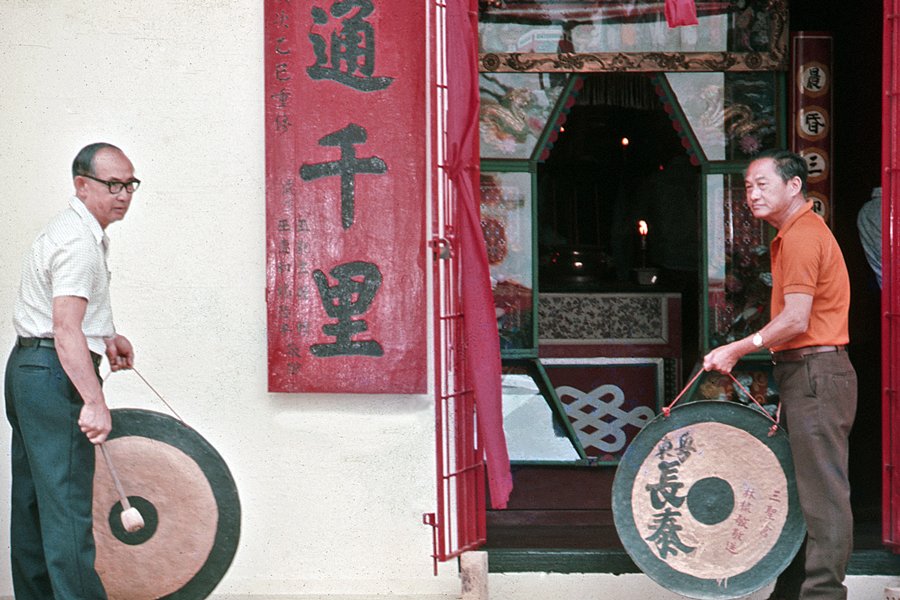

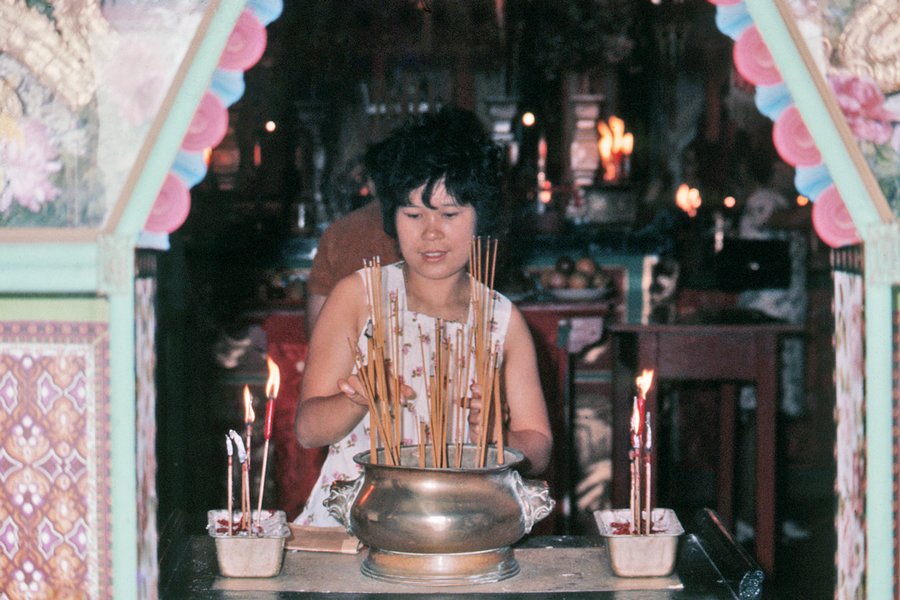
For most of the Chinese people who arrived in the colony through Brisbane during the second half of the 19th century, Brisbane lacked appeal. The city was seen as a transitory stopover on their forward journey.
The first 56 Chinese to come to Brisbane on the Nimrod in 1848 arrived as indentured labourers on five-year contracts for work as shepherds, outback handymen and on the waterfront. Brisbane's Chinese population remained relatively small throughout the remainder of the 19th century, working as furniture makers, domestic servants, market gardeners, hawkers and commercial traders.
During the 1880s, the percentage of Brisbane's population born in China remained close to half of one per cent. These relatively few Chinese settlers in Brisbane were Cantonese from five distinct clan groupings, divided into three groups: the Dongguan, the Zhongshan and the Siyi, being a combination of people from the remaining clans.
Construction of the temple was the vision of financial trustees - Chick Tong, George Shue, Way Hop, Wam Yo and Tong Wah, in an attempt to unite the five clans by providing a common community focus. To achieve this, the Buddhist temple remained open to Confucian Chinese. However, the unification of the clans would take time to be achieved.
An 1892 investigation by Alfred Archey into complaints from Brisbane’s Siyi that they were suffering continuous violent assaults by members of the Dongguan, revealed the extent of clannish divisions in Brisbane’s Chinese population. Archey described the factions as not being friendly to each other. He considered the largest group, the Dongguan, as very treacherous.
Alfred Archey noted that the 300 to 400 Dongguan were led by Fat Kee, Way Ling Loong and Wong Fun. The approximately 200 Zhongshan men's leaders were H. Yeteng of 139 Wickham St, the Valley and the photographer Mr War Sing. The 40 to 50 Siyi were led by Oh Ark, Hing Kee and Ah Foo.
The Dongguan members were always found to be the aggressors when prosecuted, even indicating who their victims would be prior to their assaults. The Dongguan then managed to follow through on their threats against all precautions.
The Dongguan had commenced a subscription fee of £2 and upward for each member in order to pay court fines and legal fees for men prosecuted for these assaults. They had also established a £5 payment for any Dongguan assaulting a Siyi and £20 for breaking limbs. While the Dongguan believed the only penalty for assault would be a fine, they had established a £1 per week retainer for any members who were imprisoned. A further agreement was in place for assaulting any interpreter or witness acting in a case against them.
對於大多數在 19 世紀下半葉通過布里斯班抵達殖民地的中國人來說,布里斯班缺乏吸引力。這座城市被視為他們地的短暫停留地。
1848 年,首批 56 名乘坐Nimrod船來到布里斯班的中國人以契約勞工的身份抵達,他們簽訂了為期五年的牧羊人、遠離城鎮地區雜工和碼頭工人的合同。布里斯班的華人人口在 19 世紀餘下的時間裡仍然相對較少,他們從事家具製造、家庭傭人、園丁、小販和商人的工作。
在 1880 年代,在中國出生的布里斯班人口比例仍然接近 0.5% 。這些在布里斯班定居的相對少數華人來自五個不同籍貫的廣東人,他們分為三個群體:東莞、中山和四邑,後者是其餘的籍貫組合。
建造寺廟是財務受託人Chick Tong、George Shue、Way Hop、Wam Yo和Tong Wah的願景,旨在通過提供一個共同的社區焦點來團結五個籍貫群體。為了實現這一目標,佛寺仍然對儒家中國人開放。但是要實現籍貫群體的團結,還需要時間。
1892 年,阿爾弗雷德·阿奇 (Alfred Archey) 對布里斯班四邑人提出的投訴進行了一項調查,即他們不斷遭受東莞人的暴力襲擊,事件揭示了布里斯班華人籍貫群體分裂的程度。 Archey 將這些派系描述為彼此不友好。他認為作為最大群體的東莞人非常凶險。
Alfred Archey 指出,東莞的 300 至 400 人由 Fat Kee、Way Ling Loong 和 Wong Fun 領導。大約200名中山男子的領袖是Valley Wickham Street 139號的H. Yeteng和攝影師 War Sing。 40 至 50 四邑人由 Oh Ark、Hing Kee 和 Ah Foo 帶領。
東莞人在被起訴時總是被認定為施暴者,甚至在襲擊前表明他們的受害者是誰。東莞人不理會警告,落實他們的威脅。
東莞已經開始徵收每人 2 英鎊及以上,以支付因這些襲擊而被起訴的男子的法庭罰款和法律費用。他們還為任何東莞人襲擊一名四邑人支付 5 英鎊,打斷四肢會支付 20 英鎊。雖然東莞人認為襲擊的唯一處罰是罰款,但他們為任何被監禁的成員設立每週一英鎊的補償费。他們還達成攻擊在案件中對他們不利的任何口譯員或證人的進一步協議。
References 文獻
Archey, A (testimony). Queensland State Archives. Item ID 86513, Correspondence, Police, 1892
Brandle, M (ed.). Multicultural Queensland 2001. Multicultural Affairs Queensland Community Engagement Division, Department of the Premier and Cabinet, Brisbane, 2001.
Cronin, K. '"The Yellow Agony": Racial attitudes and responses towards the Chinese in Colonial Queensland', in R Evans, K Saunders, K Cronin (eds.), Race relations in colonial Queensland: a history of exclusion, exploitation and extermination, 3rd edn. University of Queensland Press, St Lucia, 1993, p. 237.
Crook, DP. 'Aspects of Brisbane Society in the Eighteen-eighties', Honours. University of Queensland, 1958, p. 50.
Fisher, J. The Brisbane overseas Chinese community 1860s to 1970s: Enigma or conformity, PhD. University of Queensland, 2005, pp. 32-33.
Ip, D. 'Chinese', in M Brandle (ed.), Multicultural Queensland 2001. Multicultural Affairs Queensland Community Engagement Division, Department of the Premier and Cabinet, Brisbane, 2001, pp. 63-65.
Lilley & O'Sullivan. Queensland State Archives. Item ID 86513, Correspondence, Police, 1892.
Queenslander. 30 January 1886, p. 186.
Queensland Figaro. 4 December 1902, p. 3 (7).
Queensland Heritage Register. The Holy Triad Temple ID: 600056, 2013.
Rains, K. 'The Chinese question'. Queensland Historical Atlas, 2010.
Brisbane's Chinese migrants predominantly established businesses in a district then known as Old Frog's Hollow, within Brisbane's present-day CBD. These Chinese shops, small businesses and residences were known as the Chinese Quarter. They were mostly on the north side of Albert Street between Charlotte and Mary Streets, and extended around the corner into Mary Street.
Although the Chinese Quarter was considered unsanitary and renowned for opium and gambling, it remained frequented by local and visiting Europeans. Large Chinese retail and manufacturing businesses were also located in George, Queen and Elizabeth Streets in the city, and in Ann and Wickham Streets in the Valley.
Beyond the Chinese Quarter of Old Frog's Hollow, the City centre and the Valley, Chinese migrants had established market gardens as far afield as Ashgrove, Everton Park, Kedron, Eagle Farm, Sandgate, Nudgee, Toowong and especially on the flats around Breakfast Creek and Eagle Farm. By 1888, Brisbane depended almost entirely on these Chinese market gardeners for its supply of fresh vegetables.
The opening of the Holy Triad Temple at Breakfast Creek in 1886 saw it become a popular gathering place for greater Brisbane's Chinese community. Many of the market gardeners chose to bring their wares to the Roma Street Markets via the temple after the completion of a new metal Breakfast Creek bridge in 1889.
1880 年代,大量廣東人在布里斯班定居。布里斯班的中國移民主要在布里斯班現在的 CBD 內一個當時被稱為老蛙谷的地區開展業務。這些華人商店、小企業和住宅被稱為華人區。它們大多位於夏洛特街和瑪麗街之間的阿爾伯特街北側,並在拐角處延伸到瑪麗街。
儘管華人區被認為不衛生並且以鴉片和賭博而聞名,但當地人和來訪的歐洲人仍然經常光顧它。大型中國零售和製造企業也位於該市的喬治街、皇后街和伊麗莎白街,以及山谷的安街和威克姆街。
除了老蛙谷的中國區、市中心和山谷之外,中國移民在遠至 Ashgrove、埃弗頓公園、Kedron、Eagle Farm、Sandgate、Nudgee、Toowong 等地建立了市場花園,尤其是在早餐溪和附近的公寓。老鷹農場。到 1888 年,布里斯班幾乎完全依賴這些中國菜農供應新鮮蔬菜。
1886 年早餐溪三合會聖殿的開放使它成為大布里斯班華人社區的熱門聚集地。在 1889 年新的金屬早餐溪橋建成後,許多市場園丁選擇通過寺廟將他們的商品帶到羅馬街市場。
References 文獻
Brandle, M (ed.). Multicultural Queensland 2001. Multicultural Affairs Queensland Community Engagement Division, Department of the Premier and Cabinet, Brisbane, 2001.
Ip, D. 'Chinese', in M Brandle (ed.), Multicultural Queensland 2001. Multicultural Affairs Queensland Community Engagement Division, Department of the Premier and Cabinet, Brisbane, 2001, pp. 65-66.
Queenslander. 12 May 1888, p. 746.
Queensland Heritage Register. The Holy Triad Temple ID: 600056, 2013.
Sum Chick Tong was born in 1849, and died in 1902. Chick Tong married an English woman named Gladys and they resided in the leafy outer suburb of Swan Hill (Kelvin Grove). Chick Tong and Gladys' son, Sun Kum Chee (Shum Chick Tong), was born in Brisbane in 1885, but spent 1890 to 1911 in China receiving a Chinese education. Chick Tong became naturalised 1893.
Chick Tong was Brisbane's pre-eminent Chinese businessman during the 1880s. In 1884, Chick Tong established and controlled Brisbane's most prominent importing and trading firm, Kwong Nam Tai & Co., maintaining two shops in Queen Street, one in Albert Street, and a store in Stanthorpe. The significance of Chick Tong's position in Brisbane society enabled him to play a pivotal role in the planning, approval and construction of the Holy Triad Temple. At its opening, Chick Tong was the leader of the Chinese community and the prime trustee of the temple. However, after 1886, Chick Tong played no further leadership role in the Chinese community.
Through Kwong Nam Tai & Co., Chick Tong was responsible for importing the temple's elaborate roof from China. During the temple's opening ceremony, Chick Tong led the dignitaries with his personal £50 green silk flag, repleted with striking colour and workmanship. The flag represented the Royal Dragon of the Chinese Empire, and was hoisted up a centre flagpole, between the temple's two red flags with white mitred borders.
In 1888, Kwong Nam Tai & Co. was the main target of the 1000 strong mob during Brisbane's race riot. Kwong Nam Tai & Co. was also the only Chinese business protected by the police. By the following year, the lingering effects of the riot had played a pivotal role in the closing of Kwong Nam Tai & Co.
A meeting of Kwong Nam Tai & Co.’s creditors met on Thursday 12 September 1889 to address the company's insolvency. The firm's insolvency was credited to a depression in trade, an inability to collect outstanding debts, interest rates of up to 60 per cent on loan repayments, losses during the 1887 floods, reduction in business due to rising anti-Chinese sentiment after the 1888 riot, and mismanagement of the Stanthorpe store. During the meeting, creditors who had previously felt great sympathy for Chick Tong, and guaranteed his word as unquestionable, came to accuse him of swindling. Chick Tong was accused of lying to his creditors, as his lack of stock contradicted his claims of no sales.
In an example of racial profiling at the time, some consideration was granted that if Chick Tong had been European, he may have been able to give a good explanation for his actions. To this, one creditor demanded an explanation, claiming that Chick Tong was as good as any European in the English language and in accounting. It was suggested that Chick Tong's Jewish money lenders had taken all his stock when he failed to meet repayments. This assumption satisfied the creditors. By the meeting's close, a motion to liquidate rather than go into insolvency was put forward and was unanimously carried.
Sum Chick Tong died on Sunday 30 November 1902, in an ambulance on his way to hospital. It is notable that Queensland's most racist and anti-Chinese newspaper, Queensland Figaro (a weekly newspaper published from 1885 to 1936 in Brisbane), remembered him not only as a Queen Street businessman, but also for being a liberal supporter of the Breakfast Creek Joss House, and for his charity to the poor, when he possessed the means.
Sum Chick Tong 出生於 1849 年,並於 1902 年去世。 Chick Tong 與一位名叫 Gladys 的英國女子結婚,他們住在綠樹成蔭的 Swan Hill 郊區 (Kelvin Grove) 。 Chick Tong 和 Gladys 的兒子 Sun Kum Chee (Shum Chick Tong) 於 1885 年出生於布里斯班,但 1890 至 1911 年在中國接受中文教育。 Chick Tong 於 1893 年入籍。
Chick Tong 是 1880 年代布里斯班傑出的華裔商人。 1884 年,Chick Tong 成立並控制了布里斯班最著名的進口和貿易公司 Kwong Nam Tai & Co.,擁有兩家在Queen Street商店,另一家在 Albert Street,一家在 Stanthorpe。 Chick Tong 在布里斯班社會的重要地位,使他在三聖宮的規劃、審批和建築中扮演了舉足輕重的角色。開幕時,Chick Tong是華人社區的領袖和寺廟的主要受託人; 然而,在 1886 年之後,Chick Tong 在華人社區中沒有發揮進一步的領導作用。
通過 Kwong Nam Tai & Co.,Chick Tong 負責從中國進口寺廟精緻的屋頂。在寺廟的開幕儀式上,Chick Tong 手持他個人價值 50 英鎊,充滿醒目色彩和精細做工的綠色絲綢旗幟帶領著貴賓。這面旗幟代表中華帝國的御龍,並被懸掛在中央旗桿上,在寺廟帶有白色斜接邊框的兩面紅旗之間。
1888 年,Kwong Nam Tai & Co. 在布里斯班種族騷亂中成為 1000 名暴徒的主要目標。 Kwong Nam Tai & Co. 也是唯一一家受到警方保護的中國企業。到次年,騷亂的揮之不去的影響成為關閉 Kwong Nam Tai & Co. 的主因。
Kwong Nam Tai & Co. 的債權人會議於 1889 年 9 月 12 日星期四召開,以解決公司的資不抵債問題。該公司的資不抵債原因包括貿易蕭條、無法收回未償債務、償還貸款高達 60%的利率、1887 年洪水期間的損失、1888 年騷亂後反華情緒高漲導致業務減少,以及Stanthorpe商店的管理不善。會上,此前對Chick Tong表示同情,並保證其言行無誤的債權人,紛紛指責他詐騙。 Chick Tong 被指控向債權人撒謊,因為他的不足存貨與他聲稱沒有銷售的說法相矛盾。
在當時一個種族定性的例子中,有人考慮到如果 Chick Tong 是歐洲人,他可能能夠對自己的行為給出一個很好的解釋。對此,一位債權人要求作出解釋,聲稱 Chick Tong 在英語和會計方面與任何歐洲人一樣好。有人認為,Chick Tong 的猶太放債人在他未能償還債務時已經拿走了他所有的存貨。這一假設令債權人滿意。會議結束時,提出清盤而不是破產的動議獲得一致通過。
Sum Chick Tong 於 1902 年 11 月 30 日星期日在送往醫院的救護車上去世。值得注意的是,昆士蘭最種族歧視和反華的報章Queensland Figaro (1885 年至 1936 年在布里斯班出版的周報) 不僅記得他是Queen Street的商人,而且還記得他是Breakfast Creek寺廟的開明支持者,以及當他有能力時對窮人的善舉。
References 文獻
Brisbane Courier. 13 September 1889, p. 6.
John Oxley Library, State Library of Queensland. Neg: 10124, 2013.
John Oxley Library, State Library of Queensland. Neg: 150952, 2013.
John Oxley Library, State Library of Queensland. Neg: 197082, 2013.
Queenslander, 30 January 1886, p. 186.
Queensland Figaro. 14 January 1888, p. 76.
Queensland Figaro. 4 December 1902, p. 3 (7).
Queensland Heritage Register. The Holy Triad Temple, ID: 600056, 2013.

